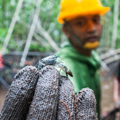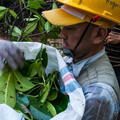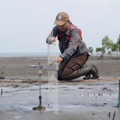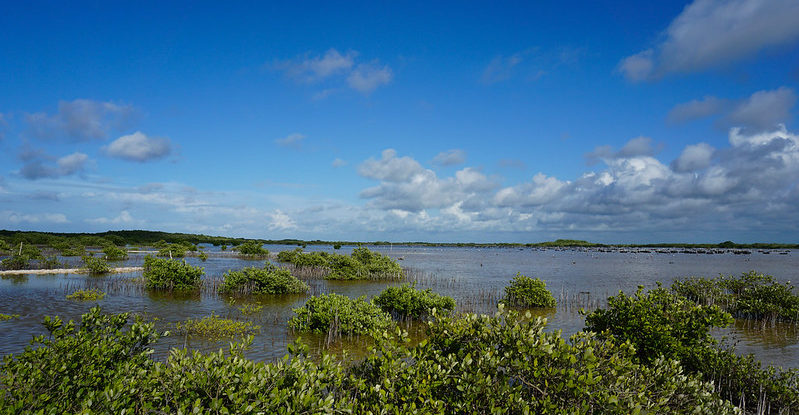Mangroves thrive in tropical coastal regions sandwiched between the land and the ocean, in areas of fresh water discharge and intertidal activity. These highly productive ecosystems are therefore amphibian trees that are threatened by both marine and terrestrial impacts. They receive storms, sea surges, and sea-level rise from the ocean. They are also hit by the expansion of lucrative activities such as aquaculture and development of touristic infrastructure on the land.
Being highly specialized, mangroves tolerate salinity and lack of oxygen in the soil where other trees would not. Their root systems are fortresses that accumulate sediments and reduce the energy of hurricane waves and sea surges. However, mangroves are also fragile. A change in their hydrological conditions could easily kill them.
In the Caribbean, where tourism is a large part of national GDPs, mangroves are being re-appreciated for their ecosystem service of coastal protection, particularly since the region is seeing an increase in extreme events such as hurricanes and droughts since the 80s. While 2017 is still remembered for its six major hurricanes, including Harvey, Maria and Irma, the U.S. National Oceanic and Atmospheric Administration (NOAA) also predicts 2020 to be another hyper-active hurricane season. Higher than normal tropical storms and major hurricanes—above category 3, with 119km/h sustained winds—are expected to happen between June to November. Many months of warmer-than-average sea surface temperature in the North Atlantic Ocean have created this risk.
Although research from the Center for International Forestry Research (CIFOR) and regional partners report on their extraordinary dynamism and their long-term ability to bounce back after disturbances, their recovery time depends on their ecosystem health. Human degradation combined with more frequent and intense extreme events can unbalance their equilibrium. So, just how resilient is their resilience?
Listen to Let’s Talk Trees as we celebrate the “super power” of mangroves with Lola Fatoyinbo, a physical scientist in the Biospheric Sciences Laboratory at NASA Goddard Space Flight Center; Steven Paton, Director of the Smithsonian Tropical Research Institute’s physical monitoring program; and Rosa Maria Roman-Cuesta, CIFOR’s tropical forest ecologist with 20 years’ experience studying forest disturbances and carbon dynamics in the tropics.
 LISTEN ON SOUNDCLOUD
LISTEN ON SOUNDCLOUD
The research and findings discussed in the podcast are part of CORESCAM-BNP Paribas Foundation project that is a living example of SDG 17 of collaborative work among many partners: Smithsonian Institution-Healthy Reefs Initiative, CATIE, CINVESTAV-Merida, Puerto Rico’s Ornithological Society, Climate Scale, University of Florida, University of East Carolina, Wageningen University, CSIC-Museo Nacional de Historia Natural, The Nature Conservancy and CIFOR.
Read more:
 The carbon on your plate: mangrove and aquaculture
The carbon on your plate: mangrove and aquaculture
 Land use change has a big impact on the carbon stored in mangroves
Land use change has a big impact on the carbon stored in mangroves
 Papua mangroves could help Indonesia coast to climate targets
Papua mangroves could help Indonesia coast to climate targets
We want you to share Forests News content, which is licensed under Creative Commons Attribution-NonCommercial-ShareAlike 4.0 International (CC BY-NC-SA 4.0). This means you are free to redistribute our material for non-commercial purposes. All we ask is that you give Forests News appropriate credit and link to the original Forests News content, indicate if changes were made, and distribute your contributions under the same Creative Commons license. You must notify Forests News if you repost, reprint or reuse our materials by contacting forestsnews@cifor-icraf.org.
